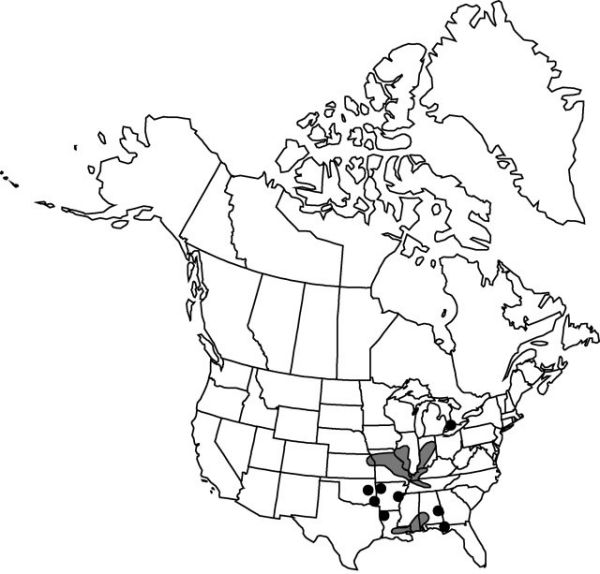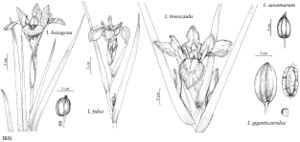Iris brevicaulis
Fl. Ludov., 20. 1817.
Rhizomes freely branching, producing extensive clumps, 1–2.5 cm diam. Stems declining or semi- erect, sharply zigzag, with short branch at each of 2–3 bends, leaf at every bend, flower bud at every bend, solid, 2.5–3 dm. Leaves: basal erect, spreading, or prostrate, blade deep green, ensiform, 3.5–7 dm × 1.5–3.5 cm, somewhat glaucous; cauline at each of 2–3 nodes, subtending and exceeding short branch and flower, blade 2–6 dm. Inflorescences with terminal unit 2-flowered, each short branch unit 1-flowered; spathes foliaceous, lanceolate, 3–5 cm, subequal, apex acute; outer green, exceeding inner; inner partly scarious. Flowers: perianth rich blue or blue-violet; floral tube funnelform, 1–2 cm; sepals ovate, 7.5–9 × 2.5–3 cm, base abruptly attenuate, claw light greenish yellow with darker veins, with prominent yellow midrib and large, yellow-white signal at union of limb and claw; petals erect or spreading-erect, lighter blue than sepals, oblanceolate, 5–6.5 × 1.5–2 cm; ovary prominently 6-angled, 1–1.3 cm; style greenish, 3.5–4 cm, crests reflexed, semiovoid to subquadrate, 1.2–1.5 cm, margins irregularly toothed or entire; stigmas 2-lobed, lobes rounded-deltoid; pedicel 1–1.3 cm. Capsules hexagonal to almost circular in cross section with 6 equally placed ribs, with short beak at apex, 3–5 × 2–2.5 cm. Seeds in 2 rows per locule, light brown, irregularly circular, flattened, 3–5 mm, very corky. 2n = 42, 44.
Phenology: Flowering Apr–Jun.
Habitat: Open, rather moist woodlands
Distribution

Ont., Ala., Ark., Fla., Ill., Ind., Kans., Ky., La., Miss., Mo., Okla., Tenn.
Discussion
Iris brevicaulis hybridizes with I. fulva to produce I. ×fulvala Dykes, and with I. giganticaerulea to produce I. ×flexicaulis Small.
Selected References
None.
